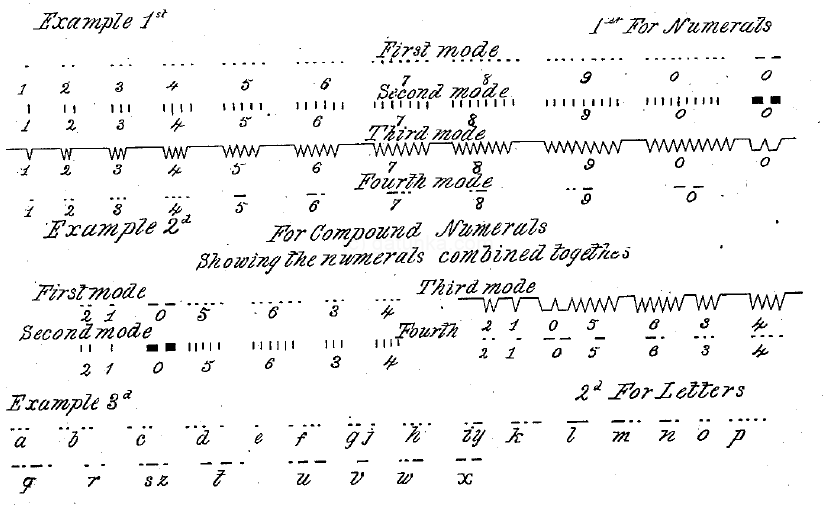Morse Telegraph Original US Patent 1647
If you hear the word Morse Code, you probably imagine people tapping on a key and listening to the code through headphones or perhaps on old-style buzzer. However, this was not how Morse originally conceived his telegraph. Here is the first patent Morse filed for his invention (filed in the 1830s and granted in the 1840s).
First, examples of codes from the patent.

We can see that the original idea started simply by representing numerals simply by clicking out “dots”, one dot for 1, 9 dots for 9, and 10 dots for 0. This then evolves into using a separate code which uses dots for 1 and “dashes” for 5, somewhat like roman numerals. From here, the idea that combinations of dots and dashes can be treated as symbolic representations (i.e. an encoding) allows for a more usable code. It is actually Morse’s assistant (Alfred Vail) who is credited with developing the modern Morse code in which frequently used letters are assigned shorter codes than less frequently used letters.
Next, we can see how Morse had intended the code to be created on pieces of metal somewhat like movable print.

These could be arranged either in linear strips or in spirals for feeding through the transmitter. An arm tracking along the top of the movable type would activate the transmitting circuit. Here is the conception of the linear model.

And here is the conception of the spiral model, which would allow much longer text to be composed.

The receiving unit has the job of printing the code as a series of zigzagging lines on paper. The drive mechanism is powered by a weight and ratchet combination like a clock.

The entire arrangement is quite straightforward.

As you can see, no code-tapping keys or buzzers in sight. However, the movable print style of composing messages was cumbersome, and was replaced with the code key before the telegraph went into service. It was also found that the operators, who needed to translate the squiggly line from the printer into letters and numbers, found it easier to decode the clicking of the printer actuator than the line, and so a buzzer was added, resulting in the form of Morse code telegraph that most of us are familiar with from movies, etc. In fact, Morse keys are still sold today. Compared to the huge table-sized devices of some of the other telegraphic methods, the Morse code key is very compact.

Related Posts
Tweet